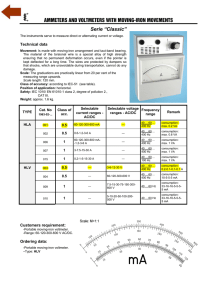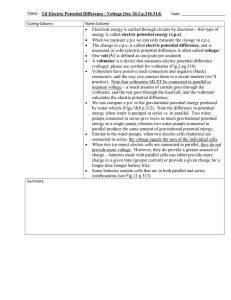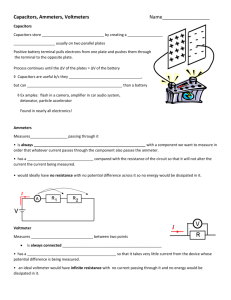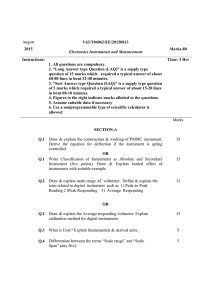JOURNAL HEWLETT-PACKARD
advertisement
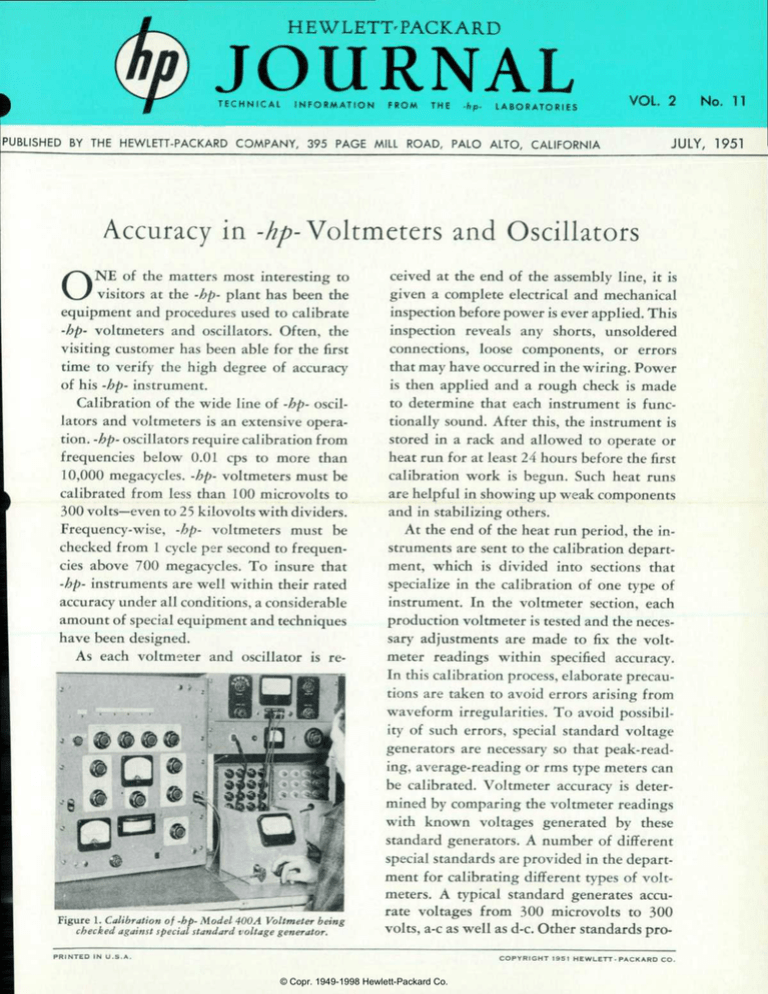
HEWLETT-PACKARD JOURNAL T E C H N I C A L I N F O R M A T I O N F R O M T H E - h p . VOL. 2 No. 11 L A B O R A T O R I E S PUBLISHED BY THE HEWLETT-PACKARD COMPANY, 395 PAGE MILL ROAD, PALO ALTO, CALIFORNIA JULY, 1951 Accuracy in -^-Voltmeters and Oscillators ONE of the matters most interesting to visitors at the -hp- plant has been the equipment and procedures used to calibrate •hp- voltmeters and oscillators. Often, the visiting customer has been able for the first time to verify the high degree of accuracy of his -hp- instrument. Calibration of the wide line of -hp- oscil lators and voltmeters is an extensive opera tion, -hp- oscillators require calibration from frequencies below 0.01 cps to more than 10,000 megacycles, -hp- voltmeters must be calibrated from less than 100 microvolts to 300 volts— even to 25 kilovolts with dividers. Frequency-wise, -hp- voltmeters must be checked from 1 cycle per second to frequen cies above 700 megacycles. To insure that -hp- instruments are well within their rated accuracy under all conditions, a considerable amount of special equipment and techniques have been designed. As each voltmeter and oscillator is re- Figure 1. Calibration of -hp- Model 400A Voltmeter being checked against special standard voltage generator. P R I N T E D I N ceived at the end of the assembly line, it is given a complete electrical and mechanical inspection before power is ever applied. This inspection reveals any shorts, unsoldered connections, loose components, or errors that may have occurred in the wiring. Power is then applied and a rough check is made to determine that each instrument is func tionally sound. After this, the instrument is stored in a rack and allowed to operate or heat run for at least 24 hours before the first calibration work is begun. Such heat runs are helpful in showing up weak components and in stabilizing others. At the end of the heat run period, the in struments are sent to the calibration depart ment, which is divided into sections that specialize in the calibration of one type of instrument. In the voltmeter section, each production voltmeter is tested and the neces sary adjustments are made to fix the volt meter readings within specified accuracy. In this calibration process, elaborate precau tions are taken to avoid errors arising from waveform irregularities. To avoid possibil ity of such errors, special standard voltage generators are necessary so that peak-read ing, average-reading or rms type meters can be calibrated. Voltmeter accuracy is deter mined by comparing the voltmeter readings with known voltages generated by these standard generators. A number of different special standards are provided in the depart ment for calibrating different types of volt meters. A typical standard generates accu rate voltages from 300 microvolts to 300 volts, a-c as well as d-c. Other standards pro- U . S . A . C O P Y R I G H T © Copr. 1949-1998 Hewlett-Packard Co. 1 9 5 1 H E W L E T T - P A C K A R D C O . M 500 kc waveform (b} 200 kc waveform Figure 2. Oscillograms of output wave form from representative r-f signal gen erators operating at low r-f frequencies. vide accurate voltages at frequencies up to more than 700 megacycles. All standards are designed to be highly flexible and many provide means for checking scales calibrated in volts or decibels. Each standard is checked several -times daily against other standard instruments. The calibration of a voltmeter logically divides itself into two basic procedures. First, the instrument is calibrated for accuracy at a low audio frequency; then, the response is adjusted to maintain the specified accuracy at all frequencies within the range of the instrument. In order to be capable of performing each of these steps, the voltage generator is constructed with a high-level oscil lator of pure waveform. The oscilla tor output is monitored by a stand ard meter of the dynamometer type whose accuracy can be referred to a standard cell. The high-level oscilla tor feeds into two attenuators. One is a high-precision wirewound at tenuator used for checking basic ac curacy of voltmeters. The second is a carbon resistor attenuator used for checking frequency response. During the final portion of the calibration process, a record card is filled out for each instrument. On this card, readings are made of some 40 to 75 voltages, depending upon the voltmeter model. Also recorded are scale linearity, the effects of line voltage changes, etc. After the cali bration is completed, the voltmeter is turned off and later periodically cycled by turning power on and off a number of times during an extend ed period. The instrument is then tested again by a different test en gineer, and the readings previously recorded on the instrument card are rechecked to determine that the in strument is stable and without drift. After passing this inspection, the voltmeter is sent to the shipping de partment and the record card re tained in permanent -bp- files. If a change of calibration is found dur ing the final inspection, the trouble is sought out and corrected and the entire calibration process repeated. VOLTMETER FIELD CHECKS Occasionally, the user of a volt meter has need for checking the calibration of his voltmeter. If no standard generator of the type de scribed above is available, field checking of voltmeters becomes dif ficult, especially at the higher fre quencies, because of the need of ob taining pure sinusoidal voltages whose values are known precisely. At low frequencies in the range below a few hundred cycles, the cali bration of a voltmeter can be checked against a dynamometer or other type standard meter. Such a check does not reveal the performance of the voltmeter at high frequencies, but does permit the basic sensitivity of the instrument to be measured. In all -bp- voltmeters one or more controls, described in the instrument manual, are provided to adjust the basic lowfrequency sensitivity of the instru ment. Probably the most practical meth od for checking the accuracy of an -bp- voltmeter above the low-fre quency range is to compare readings of the voltmeter in question with those given by one or more other -hp- voltmeters. When other -hpvoltmeters are not available for com parison checking, the satisfactory solution is to ship the voltmeter to the factory or to an authorized sta © Copr. 1949-1998 Hewlett-Packard Co. tion1 for repair. Experience has shown that this step, taken prompt ly, saves time and money in the long run. An alternate method that fre quently comes to mind for checking the high-frequency performance of a voltmeter is to compare the volt meter readings with the calibrated output of an r-f signal generator. However, there are serious deficien cies in the use of the signal generator method at low r-f frequencies and in general it is not recommended. There are several reasons for this. First, the accuracy of the power out put monitor in r-f signal generators most often is poorer than the accu racy of the -hp- voltmeter. Second, the frequency response of signal generator monitors is usually con siderably less constant than the fre quency response of the voltmeter. Several design problems in the usual signal generator contribute to the variations in response of its monitor. For one thing, the signal generator monitor frequently does not moni tor the power applied to the output attenuator but rather the level in the preceding stage. Thus, variations in coupling between the oscillator or amplifier stage and the attenuator are not indicated by the monitor. In addition to these variables, the waveform generated by signal gen erators at low r-f frequencies is sel dom good. The usual reason for this is that such frequencies lie in the lower portion of the generator's fre quency range and involve the use of tuned circuits having adverse L/C ratios. As a result, the output wave form is distorted to an extent plainly noticeable to the eye. Oscillograms2 of the output of typical signal gen erators in the lower r-f range are shown in Figure 2. Distortion of 'Such stations are located at Alfred Crossley & Associates, 4501 Ravenswood Ave., Chicago 40, Illinois, and at Burlingame Associates, 103 Lafayette St., New York 13, New York. ¿These osc.llograms were made from non -hp- generators having L-C circuits. No -bp- signal generators are produced for the frequency range under discussion. This circuit, as used in -hp- oscilla this magnitude can easily result in a monitor error of 10%, especially if tors, is designed so that Q=C2 and so the monitor circuit is that of a peakthat Ri=R2. The frequency of oscil reading voltmeter, as is often the lation of the circuit is then «=1/RC. case. If the constants of the network are On the other hand, most -hp- volt unequal, the circuit may still oscil meters are average-reading instru late, but will do so at a frequency ments calibrated with a pure sine <u=l/(CiC2RiR2)1/2. However, if the wave. The error on distorted sine network constants do not retain a waves given by peak-reading meters Figure 3. Basic circuit of RC oscillator. fixed relation as frequency is is invariably much greater than that changed, the feedback voltage ap given by the average-reading meter. ard -hp- instrument practice. After the heat-run period, oscillators are plied to the grid will vary, leading HIGH-FREQUENCY VOLTMETER sent to the oscillator section of the to dips and peaks in the generated Testing of the -hp- Model 410 calibration department, where pre voltage. 700-megacycle voltmeter presents liminary adjustments are made and The need for alignment of the special problems. Insuring the ac the dial calibrated. Both pre-cali- circuit arises from the fact that stray curacy of this instrument up to its brated and hand-calibrated dials are capacity exists from the tuning ca 700-megacycle limit requires the use used, hand-calibrated dials being pacitor to the chassis. The tuning of a voltage standard built especially favored where high resolution or capacitor in the frequency-deter for the purpose. maximum accuracy are desired. For mining network is usually a fourModel 410 voltmeters are first oscillators that have a high-frequen gang variable type, two sections of calibrated with a modified version of cy limit of less than a few mega which are connected in parallel to the procedure used to calibrate lower cycles, the dial calibration is made form one of the network capacities frequency voltmeters, and the accu with the aid of lissajous patterns on and the remaining two sections con racy of the d-c and ohmmeter cir an oscilloscope. A number of stand nected in parallel to form the second cuits in the instrument are also ard frequencies are available at each network capacity. Sometimes two checked. Then, the voltmeter is con test engineer's position for use in or more such four-gang units are nected to a special high-frequency this calibration. used. voltage standard that checks accu The adjustment and calibration of The manner in which stray capa racy out to the limit of the voltmeter. Basically, this voltage standard con the RC oscillator is an easy and quick city appears in the network is illus sists of a concentric-line oscillator process once the proper procedure is trated in Figure 4. These strays are feeding a 50-ohm line. A special fit known, but is difficult when the pro typically in the order of 30 to 50 ting similar to the Model 455A co cedure is not known. Fortunately, mmf and are of greatest significance axial "T" connector is connected into once the instrument has been aligned when the main tuning capacitor is the line as a means of applying the at the factory there is no further set for minimum capacity (about known voltage to the probe of the need in any maintenance procedure 20 mmf). for again aligning the circuit. How Effectively, most of the stray ca voltmeter. ever, instrument damage and other pacity adds to the grounded sections Measurements are also made of infrequent difficulties do bring up of the main tuning capacitor, seri the voltmeter's input capacity, in an occasional urgent requirement ously modifying the network rela put resistance at low and high fre for re-alignment. A discussion of the tionships. quencies, and other effects of transit engineering considerations in align In production equipment, the time of the high-frequency diode ing the circuit is in used in the voltmeter probe. Sub cluded here as a standard diodes or probes encoun matter of engineer tered during this checking process ing interest and for are weeded out. reference purposes CALIBRATION OF OSCILLATORS in the event of an Oscillators, as their assembly is urgent situation recompleted, are given preliminary q u i r i n g q u i c k mechanical and electrical inspec action. tions much like those given voltmet A basic circuit for ers. Oscillators also are placed in the RC oscillator is Figure 4. Diagrams illustrating unbalance of frequencymovable racks to heat run, a stand- shown in Figure 3. determining network caused by stray capacity. © Copr. 1949-1998 Hewlett-Packard Co. Figure 5. -h p- Model 400C Voltmeters on heat run. Mobile racks with built-in power outlets facilitate handling of instruments. strays are absorbed by use of trim mer capacitors (Figure 4c). In es sence, the alignment procedure con sists of adjusting these trimmers so that the capacities in the network are made equal. When hand-cali brated dials are used, only one trim mer is necessary. Pre-calibrated dials, however, are designed on the basis of a fixed maximum: minimum ca pacity ratio, necessitating the use of two trimmers for best accuracy. The recommended method for ad justing the trimmers is first to set the tuning dial precisely to a frequency at the higher frequency end of the dial. This should be done on one of the medium frequency ranges to avoid possible phase shift in the am plifier portion of the oscillator. For most -hp- oscillators where the dial calibration ends at "200," the sug gested dial setting for alignment is 2000 cps. The next step is to adjust the trim mers until the proper frequency (say 2000 cps) is generated, while at the same time the generated voltage is equal to the voltage generated at the low-frequency end of the same frequency band. For one not famil iar with this technique, the adjust ment is difficult to make at first, for there is an indefinitely large num ber of settings of the two trimmers that give the desired frequency at the wrong voltage and vice versa. One experienced with the tech nique, however, can adjust the trim mers in a matter of seconds. ally be replaced without further ad The tuning capacitors themselves justment. are aligned at the factory to have the LOW- AND HIGH-FREQUENCY proper curve. If the tuning capacitor O S C I L L A T O R S becomes accidentally bent, as some Calibration of low-frequency os times occurs, the capacitor can be cillators and low-frequency work in aligned by hand to cause the gen general have always been something erated frequency to agree with the of a special problem. When working calibration of the tuning dial. Align at frequencies too low to permit the ment of the capacitor itself consists use of a long-persistence c-r tube, of bending the split end plates by much time is consumed in making hand, starting at the minimum ca an accurate frequency check. Com pacity end of the rotor and progress mon methods for making such meas ing toward the maximum capacity urements have been to use an electro end, making all sections have equal mechanical counter and stop-watch curves. This procedure requires care or to use a recording meter. and experience, however, and is not More recently, however, the de recommended except as an emer velopment of the -hp- Model 524 A gency measure. Frequency Counter3 has introduced The resistances in the frequency- a substantial simplification into lowdetermining network also influence frequency measurements. Using this the alignment of the RC oscillator. instrument, frequencies of 0.01 cps However, it is rarely necessary to can be determined with the neces consider these resistors in a re-align sary precision by measuring the pe ment procedure. The resistors used riod of only 1 cycle of the unknown. in the network are highly stable, be Iligli-fiequency oscillators whose ing of the deposited-carbon type. frequency range is higher than a few From the standpoint of accuracy megacycles are calibrated using beatover a long period of time, these re frequency methods. A flexible fre sistors give excellent performance. quency standard that provides accu There are numerous cases where rate spot frequencies up to 10,000 such resistors, installed when the de megacycles is used for this work. posited-carbon type first became —Brunt on Bauer and R. M. Deméré available some five years ago, have 3A. S. Bagley, The High-Speed Fre remained sufficiently stable that the quency Counter— A New Solution to Old Hewlett-Packard Journal, Vol. oscillator calibration is still well Problems, 2, No. 5, January, 1951. within original specifications. There are instances, however, 1951 WESTERN IRE where a frequency-determining re CONVENTION sistor has suddenly shifted value by a large percentage, apparently be The annual combined Western IRE Con vention and Pacific Electric Exhibit will be cause of a leakage path inside the held this year in San Francisco, August seal. Such a shift will cause one range 22-24. In addition to a number of interest of the oscillator to cease operating, ing field trips and three days of technical or to operate unstably, or to develop sessions, the program includes the exten serious dial error. The simplest sive electronic exhibit in which more than 130 exhibitors will participate. method for correcting such a condi The Hewlett-Packard exhibit will be tion is to obtain a replacement range located in booths 711 and 712. -hp- instru switch assembly from the factory. ments to be exhibited include the new This assembly consists of a ceramicModel 202A 0.01 cps generator, the new insulated range switch with the fre waveguide measuring equipment, the Model 524A 10-megacycle frequency counter, and quency-determining resistors others. You are cordially invited to visit mounted on the switch body. The the -hp- booths, where a number of -hpassembly is adjusted to the necessary engineers will b« on h«nH precision at the factory and can usu © Copr. 1949-1998 Hewlett-Packard Co.

